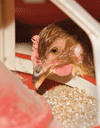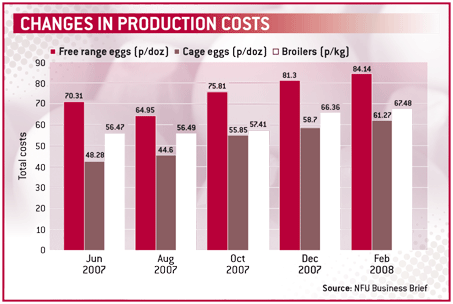Mounting costs force poultry producers to ask for price rise

Egg and broiler producers are calling for further price increases, as the relentless rise in total production costs continues in 2008, putting greater financial strains on an already fragile sector.
According to new NFU figures, free-range egg producers have seen a 19.6% increase in costs from June 2007 to February and a similar percentage rise for broiler producers. Cage egg producers saw a staggering 26.9% increase in costs, adding an extra 13.8p/doz.
These increases are mainly due to feed price rises and its effects on pullet rearing costs for layers, while for broilers, it’s down to rises in feed plus energy and water charges.
Commenting on the increases, NFU poultry board chairman Charles Bourns highlighted two problems. First, it’s not just feed costs.
“If producers at least receive an increase to cover the extra feed costs, other costs have also gone up and this has resulted in a growing number of farmers shutting their doors. For example, one integrated company has recently shut the doors on two of its sites holding 200,000-300,000 birds.”
Second, non-integrated units that buy feed from outside sources are paying more. There seems to be a price differential between integrated units paying somewhere between the high £220s to mid £230s a tonne and non-integrated units paying £250s-270s. This £30/t difference roughly equates to an extra farm cost of 11-12p/chicken produced.

“I can’t work out why there is such a difference,” said Mr Bourns.
“Increasing numbers of producers are now shutting doors and unless we see price rises come through, the industry could end up like pig sector. I believe that no one will be making much money in the next few months.
“My key message is that these higher costs are here to stay and if retailers want British chicken, they will need to pay for it. British chicken farming is not a charity.”
It’s not just the day-to-day running costs, there are the costs of complying with new rules, such as Integrated Pollution Prevention and Control. There is a lot of investment needed on units to comply with the IPPC environmental targets.
“Looking at NFU membership, 75% of all poultry producers are NFU members. Of these members, only 20% are poultry only – the remainder have other enterprises alongside, such as arable. So they don’t have to do poultry farming and the short-sightedness of a few retail buyers risks the loss of the industry,” said Mr Bourns.
Also, some retailers are promoting themselves on selling 100% British chicken. “But I would rather see a retailer selling 80% British chicken and paying its suppliers a fair price than one at 100% British chicken and paying less for it, with poultry suppliers struggling to make ends meet,” he said.
On the egg side, the British Free Range Egg Producers’ Association is calling for a 5p/doz increase. It highlights that in the period since the 10p/doz increase last autumn, the cost of feeding layers has increased, swallowing up half that increase.
“At the time the increase looked sufficient because we were optimistic that feed costs would level off,” said BFREPA chairman Tom Vesey. “Regrettably that hasn’t been the case and within a matter of months producers are once again facing severe financial hardship.”
And with feed costs predicted to continue rising between now and harvest, Mr Vesey is concerned that a 5p rise may not prove enough.
“Five pence is the very minimum we need and it could prove to be insufficient if the gloomy predictions for feed prices prove correct,” he said.
He added that on top of this was the knock-on effects of high feed costs on pullet price as well as spiralling fixed costs, particularly fuel and power.
Particularly hard hit is the organic egg sector which has seen costs rise. Hampshire-based organic feed compounder Humphrey Feeds has warned that unless retailers act, the organic egg sector faces collapse.
